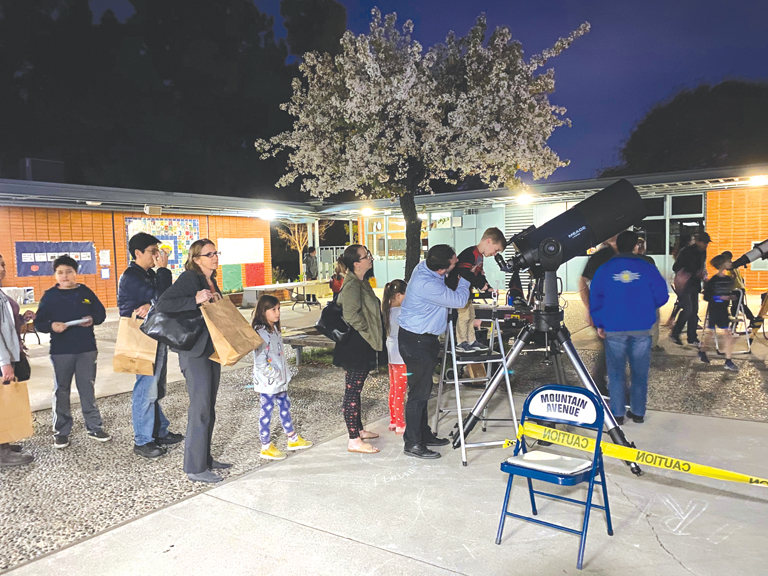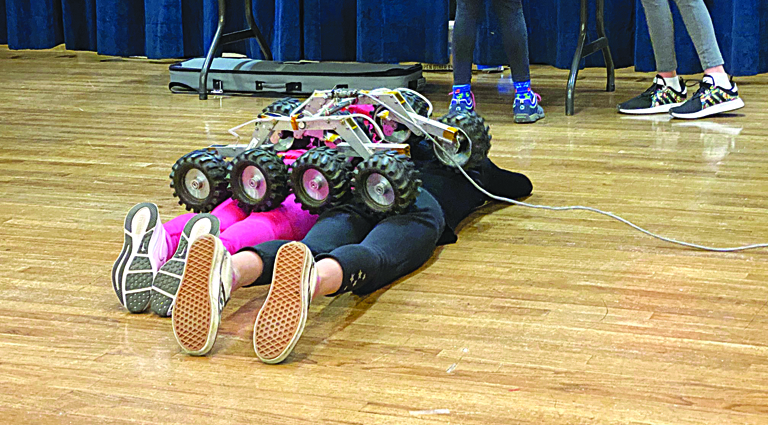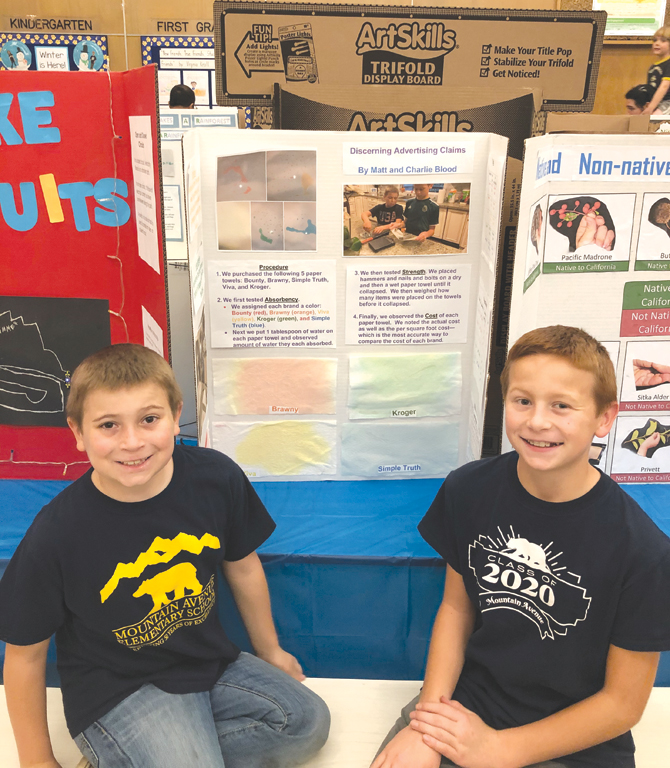
Families looked through telescopes set up at the science fair.
By Lori BODNAR, intern
Over 200 students and their families had a fun-filled night of exploration and discovery at Mountain Avenue Elementary School’s 11th Annual Science Fun Fair on Friday, Jan. 31. Attendees made light-sensitive color changing slime, gazed at the Moon through telescopes, and learned about the cosmos inside the Kidspace Discovery Dome inflatable planetarium. Inside the planetarium, students learned about the eight planets, various constellations and the North Star. The light-focused theme for the science fair was, “Light the Path to Discovery!”
Nearly 150 students from transitional kindergarten through sixth grade completed science fair projects. All received a certificate, ribbon and science prizes, which this year included a magnifying lens, a glowstick, and rainbow spectrum glasses. The glasses made an aura of rainbows surround everything since the glasses divided white light into the complete spectrum of colors. There was no judging of the science projects. The Synopsys Outreach Foundation donated poster boards.
In addition to the science fair projects, over 50 sixth graders competed in teams of two to five students in The Great Paper Roller Coaster Engineering Build Challenge.

The goal of the paper roller coasters was to keep a marble rolling the farthest distance down a paper roller coaster. Fifteen teams built the coasters during school recess over a period of two weeks, then raced them at the science fair family night surrounded by cheering fans, friends and family members. The winning coaster was also one of the tallest and built by the team of Andrew Klein, Alec Heberger, Gage Stallcup and Sammy Arias.
Sammy said, “The triangle wedges on our roller coaster track slowed the marble down to help us win first place.”
Sixth grader Matt Blood also participated in the roller coaster race.

“My favorite part of the science fair was doing the roller coaster challenge with my friends,” Matt said. “It was really cool trying to come up with the longest roller coaster.”
The students could also decorate their coasters and prizes were awarded in a variety of categories including best theme, which went to a “Star Wars” coaster that had a marble roll through the center of the Death Star much like Luke Skywalker’s X-wing ship. The team that won the best theme was Christian Carr, Elijah Bursch, Matt Blood and Joshua Yang.
Attendees enjoyed a plethora of exciting and interesting student science projects, such as Jung-Jae Yoon’s Camera Obscura, which was a large walk-in cardboard box that used an optical phenomenon to create an upside-down image from a pinhole camera. Matthew Blood and Charlie Blood built a project about discerning ad claims.
“[We wanted] to find out if the ads for the best paper towel brand were correct,” said Charlie, who is in the third grade. “We wanted to know which the best brand is based on strength, absorbency and value.”
“My brother and I had a lot of fun working together,” added brother Matthew, who is in sixth grade. “I was proud of our project.”
Charlie said that the aspects he particularly enjoyed was employing teamwork to get the project done. “We did a lot of material testing on the five brands of paper towels.”
Other interesting science fair projects included Banana Piano in which students completed a circuit with human conductivity in order to play a medley of musical notes on a bunch of bananas, created by third-grade friends Laura Lund and Suzanna Bodnar. There were also intriguing science projects involving dinosaurs, deer, rabbits, pangolins, rainforests, volcanoes, magnets, rockets, airplanes, solar system models, slime, oobleck, capillary action, buoyancy, magnetism, solar energy, wind turbines, rock/mineral collections, computer coding and even a handful of engineering projects such as a shower water conservator and a candy-vending machine.
Pranav Arunachalam did a science project about the different kinds of forces in the universe, such as gravity and friction, entitled May the Force be With You. His brother Vivek’s science project was about how leaves change color.
“The science fair brings all our students and families together,” said Principal Jaclyn Scott. “This year we had the Kidspace Discovery Dome Planetarium and the Los Angeles Astronomical Society Club of amateur astronomers bring their telescopes for students to view the craters of the Moon. Science fair brings many learning opportunities to students.”
PTA members Jackie Bodnar and Meena Arunchalam co-chaired the Science Fun Fair.
“Science Fair brings awareness of science and can encourage students to be interested in STEM, or science, technology, engineering, and math,” said Arunchalam. “We have science all around us.”
“I have enjoyed being a PTA co-chair for the Science Fun Fair at Mountain Avenue for over 10 years,” said Bodnar. “Every year, I am amazed at the variety, depth, and creativity of the student science projects. It’s rewarding to see the student’s excitement when they are explaining their project to their classes and teachers.”
The Crescenta Valley High School Academy of Science and Medicine, the Rosemont Middle School California Junior Scholarship Foundation and Rosemont Builders Club all volunteered at the Science Fun Fair.
The telescopes and inflatable planetarium were new additions to the science fair. The Los Angeles Astronomical Society set up telescopes for the students to view the Moon, different planets and stars.
Phil Taylor, a member of the Astronomical Society, said, “We go to schools all over the area and show kids the sky with our telescopes. We bring astronomy to the people so that they can engage in science. I’ve been doing the outreach for 40 years but have been involved in astronomy for over 60 years.”
Kidspace provided the inflatable planetarium Discovery Dome.
Anthony Bustamante, the group program coordinator at Kidspace, said, “We take the inflatable planetarium on the road with us. It is never at the museum. The planetarium is used for special occasions. We can see planets and constellations in real time.”
Students and their families enjoyed stargazing, glimpsing the Moon craters and planets, and exploring the cosmos with the telescopes and the planetarium.
Traditional crowd-pleasers at the science fair were also present, including the Mars rover brought by JPL scientist Umaa Rebbapragada. The Mars Rover was up on center stage, where interested students could lay down on the stage and have the rover roll over them. Another robotic treat was the CVHS Falcon FLL 589 robotics team, who brought its coding robot “Interstellar.” The CVHS robotics team is coordinated by Lyn Repath-Martos and Greg Neat.
Besides the robots, telescopes, planetarium, and amazing student projects, there were also other “hands-on” science activities run by the high school and middle school volunteers. These included a Van de Graaf generator to make people’s hair stand on end, and a plasma globe that students could touch to have the beams of colored light follow their fingers as they learned about the most abundant state of matter in the universe: plasma. Students also explored rainbows and prisms. Other activities included chewing wintergreen mints in the dark while looking in a mirror to see the sparks given off from chewing, a phenomenon known as triboluminescence.
Arts and crafts activities were also available, such as dot-art rainbows or making constellations out of sticker-stars and chalk.
There were many different fun science activities to choose from to keep the students engaged with fun, hands-on science learning, in addition to viewing the 150 student science projects. To top off the night, the Arunchalam and Bodnar families exploded the ever-popular Diet Coke/Mentos geyser that blasted soda over 20 feet in the air.
